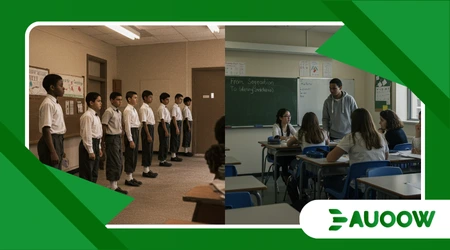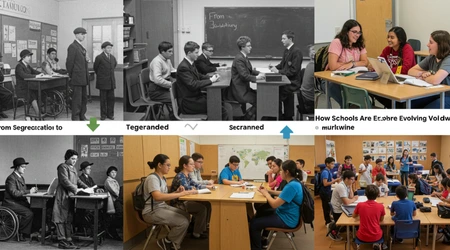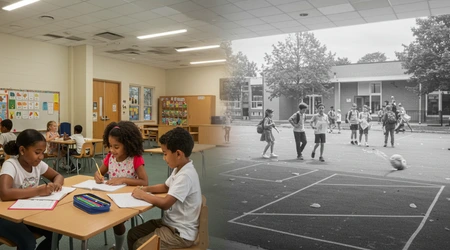From Segregation to Inclusion: How Schools Are Evolving Worldwide

From Segregation to Inclusion marks a profound shift in global education systems. Schools worldwide now embrace diverse learners together. This evolution challenges old barriers.
Educators drive this change actively. They integrate students with disabilities into mainstream classrooms. Policies support equal access everywhere.
Parents advocate fiercely for their children’s rights. Governments respond with new laws. Communities benefit from richer interactions.
Technology aids this transition. Tools like adaptive software help all students thrive. Innovation accelerates progress daily. Yet hurdles remain. Resource shortages slow implementation in many regions. Commitment varies across nations.
We explore real-world transformations here. Drawing from current reports, we highlight successes and obstacles. Engagement starts with understanding.
Why do some schools lag? This rhetorical question pushes us to examine systemic issues. Answers lie in collaborative efforts.
Historical Roots of Segregation
Nations once isolated students based on abilities. Special schools separated children with disabilities. This practice stemmed from outdated views.
Society viewed differences as deficits. Educators reinforced divisions through curriculum designs. Change began with advocacy movements.
International agreements sparked reforms. The UN Convention on Rights of Persons with Disabilities led the way. Countries signed on eagerly.
Segregation harmed social development. Students missed peer interactions. Isolation bred stigma and inequality. Activists challenged these norms. They organized protests and lobbied lawmakers. Gradual shifts followed.
++ Pilots of inclusive education models like Maine’s new program
By mid-20th century, experiments in integration emerged. Pilot programs tested mixed classrooms. Results showed benefits quickly.
Critics argued for specialized support. Debates raged in education circles. Evidence tilted toward unity. Today, history informs policy. Leaders reference past mistakes. They build inclusive frameworks actively.
Echoes of segregation persist in some areas. Rural schools struggle most. Urban centers adapt faster. Reflection drives improvement. Educators study historical data. They apply lessons to current practices.

The Global Push for Inclusion
World leaders prioritize unity in learning. UNESCO champions this through annual reports. Nations align their strategies.
From Segregation to Inclusion gains momentum via international forums. Conferences unite experts yearly. Ideas flow freely.
Funding boosts these efforts. Donors invest in teacher training. Programs expand rapidly. Technology integrates diverse needs. Apps customize lessons for individuals. Accessibility improves outcomes.
Parents form support networks. They share experiences online. Advocacy grows stronger. Schools redesign spaces actively. Ramps and sensory rooms appear. Environments welcome everyone.
Also read: UNESCO’s Roadmap for Inclusive Education: What’s New
Policy makers enforce standards. Audits ensure compliance. Progress reports track advancements. Challenges prompt innovation. Shortages inspire creative solutions. Communities collaborate effectively.
Global partnerships accelerate change. Organizations like UNICEF lead initiatives. Impact spreads widely. Educators adapt curricula. They incorporate universal design principles. Learning becomes equitable.
Success Stories from Around the World
Israel transforms its system steadily. From segregated setups, schools now mix students. Policies emphasize shared spaces. In Saudi Arabia, reforms evolve education. New decrees mandate inclusion. Teachers receive specialized training.
New Jersey launches inclusion projects. Academies train staff intensively. Results show higher engagement.
From Segregation to Inclusion inspires Brazilian models. Public schools integrate neurodiverse learners. Community involvement keys success.
Read more: Inclusive Education in 2025: Global Best Practices You Should Know
Finland leads with holistic approaches. All students learn together. Outcomes rank high globally. Australia implements national strategies. Disability standards guide practices. Improvements reduce dropouts.
Kenya builds inclusive hubs. Rural areas see changes. Partnerships with NGOs drive efforts. Canada focuses on Indigenous inclusion. Cultural sensitivities shape programs. Respect fosters unity.
Europe’s regional reports highlight gains. Central Asia adapts leadership models. Inclusion strengthens societies. Africa pushes for equity. South African schools evolve post-apartheid. Diversity enriches classrooms.
Challenges Schools Face Today
Resource gaps hinder progress. Many schools lack trained staff. Budgets fall short often. Attitudes resist change. Some educators doubt inclusion’s efficacy. Training addresses this actively.
Infrastructure poses barriers. Old buildings need upgrades. Renovations demand investment. Parental concerns arise frequently. Fears about quality persist. Communication eases worries.
Policy inconsistencies confuse implementation. Varying standards across regions. Harmonization proves essential. Cultural biases linger. Societies value uniformity sometimes. Education counters these views.
Technology access varies. Rural areas lag behind. Equity requires targeted aid. Assessment methods need overhaul. Traditional tests disadvantage some. Adaptive evaluations emerge.
Collaboration demands effort. Teams coordinate services. Integration improves efficiency. Monitoring progress challenges leaders. Data collection varies. Standardized metrics help.
Innovative Approaches in 2025
AI personalizes learning paths. Tools analyze student needs. Educators adjust lessons dynamically. Virtual reality simulates experiences. Students explore safely. Inclusion extends beyond walls.
Peer mentoring programs thrive. Older kids guide newcomers. Bonds form naturally. Community partnerships enhance resources. Local businesses donate equipment. Support networks expand.
Curriculum redesigns focus on strengths. Project-based learning engages all. Creativity flourishes. Professional development evolves online. Webinars reach global audiences. Knowledge spreads quickly.
From Segregation to Inclusion leverages data analytics. Schools track inclusivity metrics. Improvements follow evidence.
Sensory integration techniques advance. Calming spaces reduce overstimulation. Focus improves for many. Gamification motivates learners. Apps turn lessons fun. Participation rises sharply. Policy labs test ideas. Pilot projects inform scaling. Successes replicate worldwide.
The Role of Leadership in Inclusion

School principals drive cultural shifts. They model inclusive behaviors daily. Teams follow suit. Training equips leaders effectively. Workshops cover diversity strategies. Confidence builds rapidly.
Vision statements prioritize unity. Leaders communicate goals clearly. Staff align actions. Accountability measures ensure progress. Reviews assess inclusion efforts. Adjustments occur promptly.
From Segregation to Inclusion requires bold decisions. Leaders allocate resources wisely. Impact maximizes. Collaboration with stakeholders strengthens. Parents join planning sessions. Input enriches plans.
Innovation stems from top. Leaders encourage experiments. Failures teach valuable lessons. Mentorship programs guide new principals. Experienced ones share insights. Expertise transfers smoothly.
Global networks connect leaders. Forums exchange best practices. Ideas adapt locally. Evaluation frameworks evolve. Leaders use data-driven approaches. Outcomes improve steadily.
Here is a table summarizing key global statistics on inclusion gaps, based on World Bank and UNICEF data from 2025:
| Region/Aspect | Statistic | Source |
|---|---|---|
| Global Children with Disabilities | 291.2 million | World Bank (March 2025) |
| Never Attended School Likelihood | 2.5 times more for children with disabilities | World Bank (March 2025) |
| Out-of-School Children Worldwide | 272 million | UNESCO (June 2025) |
| Disabilities Overlooked in Policy | Often in policymaking | UNICEF (2025) |
This table highlights disparities actively. Educators address these through targeted interventions.
Future Outlook for Inclusive Education
Trends point to tech integration. AI will customize more. Accessibility reaches new heights. Policy harmonization accelerates globally. Nations adopt shared standards. Unity strengthens efforts.
Community involvement deepens. Parents lead advocacy groups. Voices amplify changes. From Segregation to Inclusion predicts hybrid models. Blended learning accommodates all.
Sustainability focuses on long-term. Funding secures ongoing support. Progress endures. Research advances understanding. Studies inform practices. Evidence guides decisions.
Workforce preparation evolves. Inclusive skills become standard. Graduates thrive diversely. Global crises test resilience. Pandemics highlight needs. Adaptations build stronger systems.
Educators innovate continuously. New tools emerge yearly. Inclusion becomes norm. Societies benefit holistically. Diverse perspectives foster innovation. Future brightens.
Imagine schools as vibrant mosaics. Each piece unique, yet forming a cohesive whole. This analogy captures inclusion’s essence. One original example: In a Tokyo elementary school, students with autism join robotics clubs. Peers collaborate on projects, building empathy organically.
Another: A Mexican village school uses local folklore in lessons. Children with hearing impairments participate via sign-integrated storytelling, enriching cultural ties.
According to UNESCO’s 2024/5 Global Education Monitoring Report on Leadership in Education, school leaders play pivotal roles in fostering inclusion, yet only 40% receive specific training worldwide.
From Segregation to Inclusion transforms societies. Barriers fall as unity rises. Education empowers everyone. Leaders commit to equity. They invest in training and resources. Futures brighten for all.
Communities celebrate diversity. Schools reflect real worlds. Interactions build understanding. Technology bridges gaps. Innovations make learning accessible. Potential unlocks daily.
Parents witness growth. Children flourish together. Bonds last lifetimes. Global cooperation accelerates. Nations share successes. Progress multiplies exponentially.
Challenges turn opportunities. Resilience defines the journey. Inclusion prevails ultimately. From Segregation to Inclusion inspires hope. Worldwide evolution continues. Join the movement today.
Frequently Asked Questions
What drives the shift from segregation to inclusion in schools? Advocacy, policies, and evidence of benefits fuel this change.
How can parents support inclusive education? Engage with schools, advocate for resources, and foster home acceptance.
Are there global standards for inclusion? Yes, UN conventions guide nations, though implementation varies.
What role does technology play? It personalizes learning and enhances accessibility for diverse needs.
How do we measure inclusion success? Through student outcomes, engagement metrics, and feedback surveys.
From Segregation to Inclusion faces resistance where? In resource-scarce regions, cultural biases persist.
Can inclusion work for all disabilities? With proper support, yes, though adaptations are key.
What’s next in 2025 trends? AI and virtual tools will dominate, expanding reach further.
